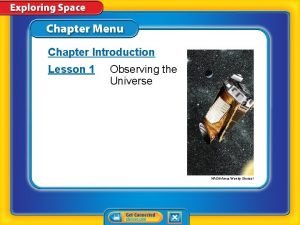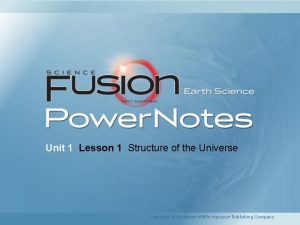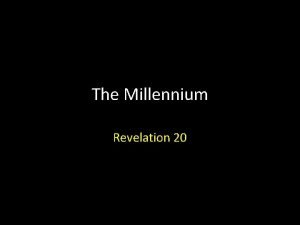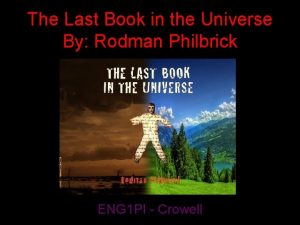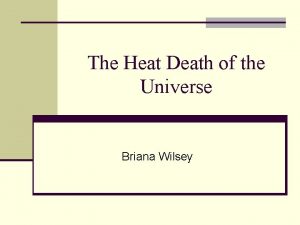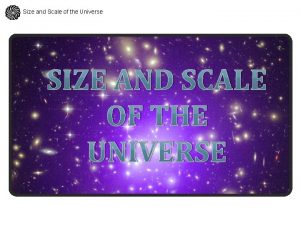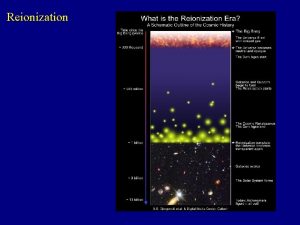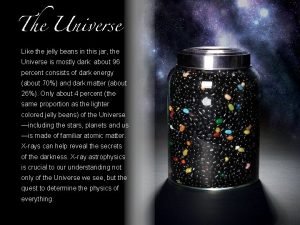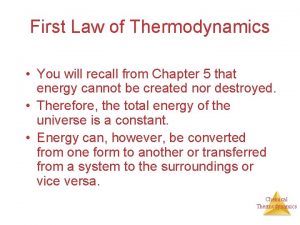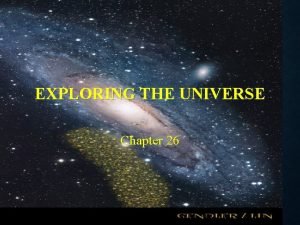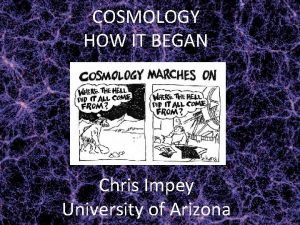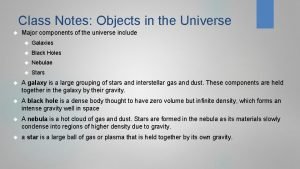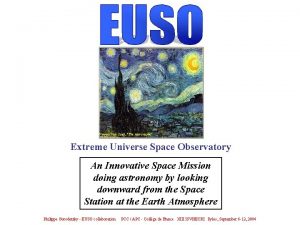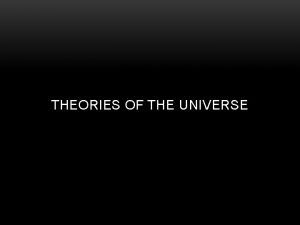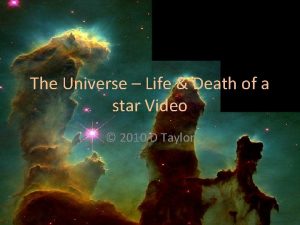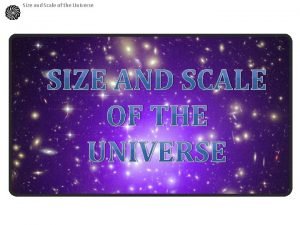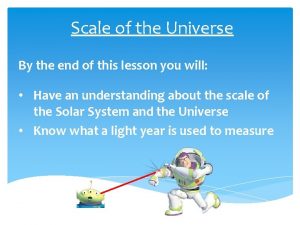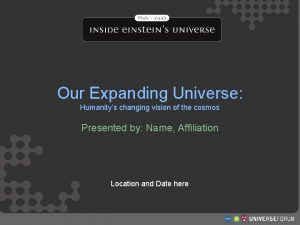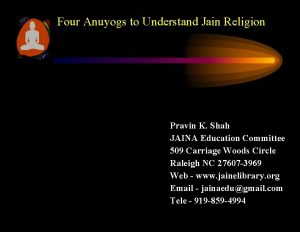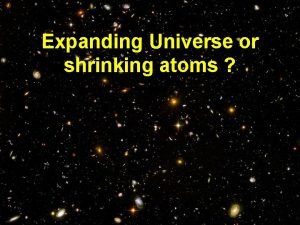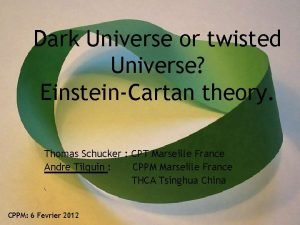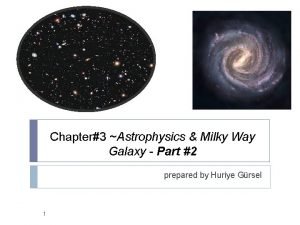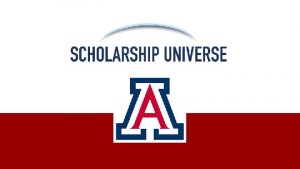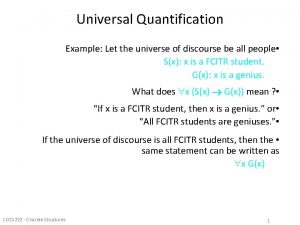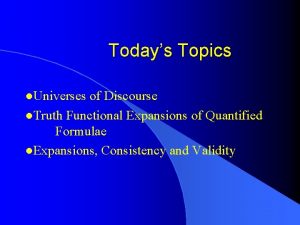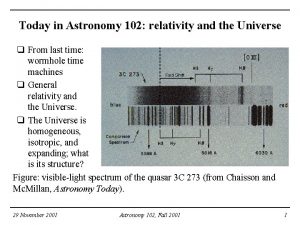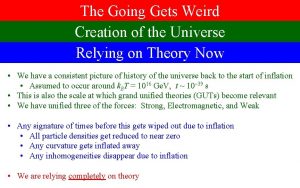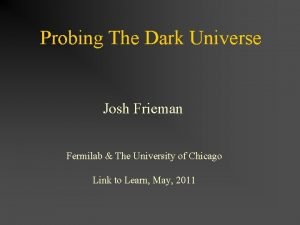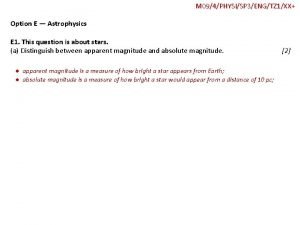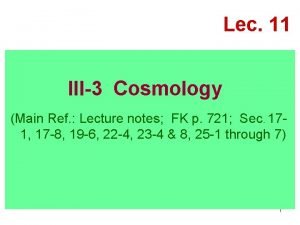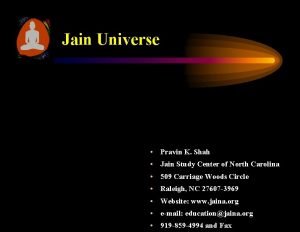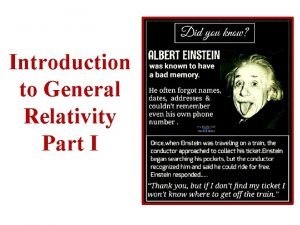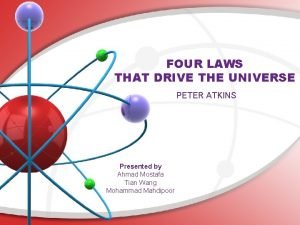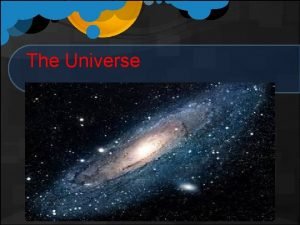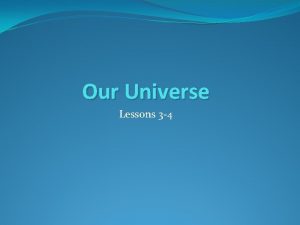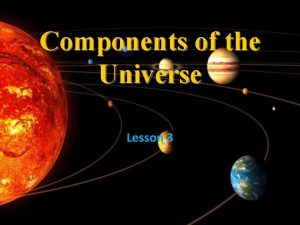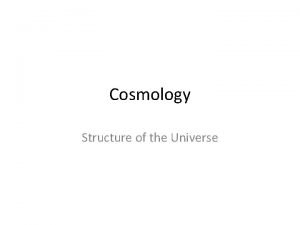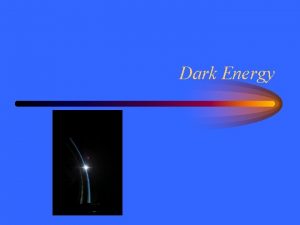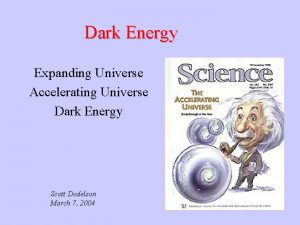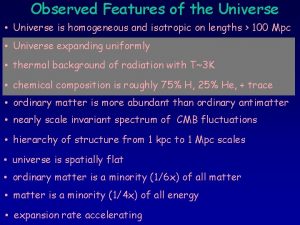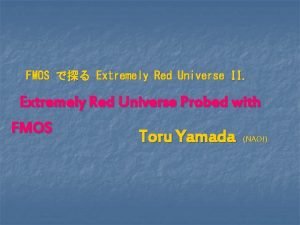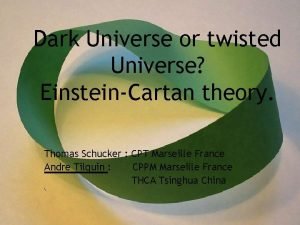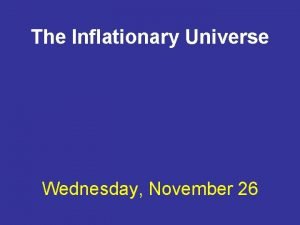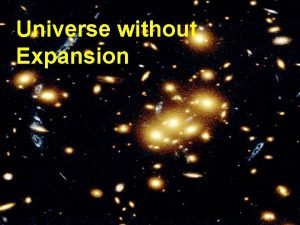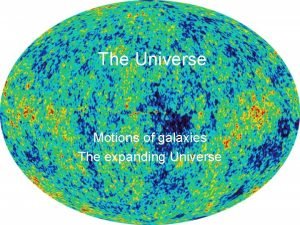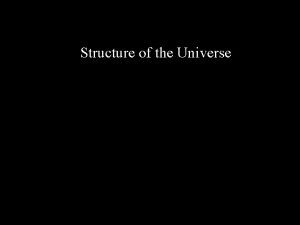UNIT 11 CHARACTERISTICS OF THE UNIVERSE Lesson 1





































































































- Slides: 101

UNIT 11 CHARACTERISTICS OF THE UNIVERSE Lesson 1 Classifying Stars

WARM UP • Are all stars the same size? • No • Are all stars the same temperature? • No • Are all stars the same age? • No

TEST REVIEW • Each question is worth 10 points

GALAXIES AND STAR CARDS • Organize the cards into groups that make sense to you. • Be prepared to justify your answer • You have 5 minutes

GALAXIES AND STAR CARDS • Justify your answer • Table 1 • Table 5 • Table 6 • Table 4 • Table 2 • Table 3

GALAXIES • • • Using the computers, you are going to research a type of galaxy. Your letter represents: • A- irregular galaxies • Sit at tables 1 and 2 • B- elliptical galaxies • Sit at tables 3 and 4 • C- spiral galaxies • Sit at tables 5 and 6 You have 10 minutes to conduct your research You will be sharing this information with your peers. Make sure it is quality work and you use scholarly websites.

GALAXIES • Make GROUPS • Each group must have an A, B, and C person • You will have 5 minutes to share info

CHECK ANSWERS

CHECK ANSWERS

CHECK ANSWERS

WARM UP • Describe an Irregular galaxy. • Undefined shape, no symmetry • Describe a Spiral galaxy. • Disk shaped, resembles a pin wheel • Describe an Elliptical galaxy. • Round to flattened or elongated spheres

VIDEO • http: //studyjams. scholastic. com/studyjams/science/solarsystem/universe. htm

GALAXIES • What kind of galaxy is this? • Irregular

GALAXIES • What kind of galaxy is this? • Spiral

GALAXIES • What kind of galaxy is this? • Elliptical

GALAXIES AND STAR QUESTIONS • Instead of taking notes over this Power. Point, you will answer the questions as we go • Pay attention because I did not highlight any of the information for you

THE UNIVERSE… …is space and everything in it.

GALAXIES • A galaxy is a cluster of stars, gas, and dust that are held together by gravity. • There are three main types of galaxies: • Irregular • Elliptical • Spiral

TYPES OF GALAXIES – IRREGULAR… • Some galaxies do not have definable, regular shapes and are known as irregular galaxies. • They contain young stars, dust, and gas.

TYPES OF GALAXIES – ELLIPTICAL. . . • Elliptical galaxies look like flattened balls. • These galaxies contain billions of stars, but have little gas and dust between the stars. • Because of the lack of gas and dust, new stars cannot form in most elliptical galaxies, and so they contain only old stars.

TYPES OF GALAXIES –SPIRAL… • Spiral galaxies consist of a flat, rotating disk with stars, gas, and dust and a central concentration of stars, known as the bulge. The bulge is surrounded by a much fainter halo of stars. • Contains middle aged stars

TYPES OF GALAXIES – BARRED SPIRAL… • Our Milky Way galaxy has recently (in the 1990 s) been confirmed to be a type of spiral galaxy known as a barred spiral galaxy. • Our Sun is located at the edge of the Milky Way galaxy.

GALAXIES AND STARS • How are galaxies classified? • Where is our Sun located in the Milky Way Galaxy?

VIDEOS • http: //www. youtube. com/watch? v=UE 8 y. Hy. Si. J 4 A • Open Notes or u. Pad • Write 4 sentence about what you think or feel about what we have learned so far about space. • Include your name and data on the top • Let this video clip motivate your • http: //www. youtube. com/watch? v=ep. Tmlb. JHZv 4

WARM UP • Where is our Sun located in the Milky Way Galaxy? • On the edge • Where size star is our Sun? • Medium

LIFE CYCLE OF A STAR • With your shoulder partner sort these cards. • Be prepared to justify your answer

LIFE CYCLE OF A STAR • Volunteers to share your answers

LIFE CYCLE OF A STAR • What might the Human Life Cycle sequencing activity have to do with stars? • If galaxies are made up of a collection of stars, dust, and gas, then where do these stars come from? • Stars undergo a life cycle that could be compared to a human life cycle. • Remember: a star has never been alive. • Stars will go through a sequential cycle and then cease to exist. • A star’s life cycle depends on its mass.

• Open the Galaxies and Star questions from Friday

NEBULAE • Stellar Nebula- A gigantic cloud of gas and dust from which stars are made; sometimes called a “Stellar Nursery” • Planetary Nebula- When a star runs out of fuel to burn, its outer layers of gas are blown outward in the shape of a ring. (PLURAL FOR NEBULA)

STARS • A star contains hydrogen gas that forms helium through a process known as nuclear fusion. Stars form when gravity pulls together gas and dust from stellar nebula. • It releases enormous amounts of energy which causes the star to become very hot and glow. • Vary in mass, size, and temperature • Held together by gravity.

A STAR IS BORN… • A star is made up of a large amount of gas, in a relatively small volume. • A stellar nebula, on the other hand, is a large amount of gas and dust, spread out in an immense volume. • All stars begin their lives as parts of stellar nebulas.

LIFE CYCLE OF A STAR • With your shoulder partner sort these cards. • Be prepared to justify your answer

GALAXIES AND STAR CARDS • Justify your answer • Table 1 • Table 5 • Table 6 • Table 4 • Table 2 • Table 3

A STAR IS BORN… • Gravity can pull some of the gas and dust in a nebula together. • The contracting cloud is then called a protostar. • A star is born when the contracting gas and dust become so hot that nuclear fusion begins.

LIFETIMES OF STARS… • Before they can tell how old a star is, astronomers must determine its mass. • Medium mass stars, such as the Sun, exist for about 10 billion years. • These are known as main sequence stars.

LIFETIMES OF STARS… • Stars with more mass have shorter lives than those with less mass. • Small stars use up their fuel more slowly than large stars, so they have much longer lives, about 200 billion years.

LIFETIMES OF STARS… Stars form in a stellar nebula, from collapsing clouds of interstellar gas and dust. This is called a protostar. When a star runs out of fuel, it will become a white dwarf, neutron star, or black hole. The rest of the life cycle depends on the mass of the star

MAIN SEQUENCE STARS… • Main Sequence is the stage in which stars spend the majority of their lifetime. • Small and medium stars first become red giants. • Their outer layers expand during the red giant phase. • Eventually, the outer parts grow bigger still and drift out into space.

MAIN SEQUENCE STARS. . . • The blue, white, hot core is left behind causing a white dwarf • When there is no more energy, it becomes a black dwarf. It is the remaining burnt-out cinder left, as the star goes out.

• A dying giant, or supergiant star, can suddenly explode. Within hours, the star blazes millions of times brighter. • The explosion is called a supernova.

NEUTRON STARS… • After a star explodes, some material from the star is left behind. This material may become part of a planetary nebula. • The core will compress and form a neutron star. • Neutron stars are even smaller and more dense than white dwarfs.

BLACK HOLES… • The most massive stars may have more than 40 times the mass of the Sun. One might have more than five times the mass of the Sun left, after it becomes a supernova. • The gravity of this mass is so strong that the gas is pulled inward, packing it into a smaller and smaller space. These massive stars become black holes when they die.

GALAXIES AND STARS • Protostar is like an infant • Main Sequence like our Sun is like a toddler through teen • Red giant/supergiant is like an adult through middle age • White dwarf/black hole is like old age and death

WARM UP

PREVIEW • http: //www. youtube. com/watch? v=PM 9 CQDl. QI 0 A

LIFE CYCLE OF A STAR • Open Life Cycle of Stars Graphic Organizer • As we go through the Power. Point you will complete their Life Cycle of Stars Graphic Organizers and finish completing their Galaxies and Stars Questions which we will talk more about tomorrow.

STAR LIFE CYCLE

Generally speaking, there are two main life cycles for stars. The factor which determines the life cycle of the star is its mass. 1 solar mass = size of our Sun Any star less than about three solar masses will spend almost all of its existence in what is called the “Main Sequence”. Star Basics

• Space may seem empty, but actually it is filled with thinly spread gas, mostly hydrogen, and dust. • The dust is mostly microscopic grains of carbon and silicon. In some places, this material is collected into a big cloud of dust and gas, known as a nebula. • Stars form from collapsing clouds of gas and dust. All stars begin in a nebula. STELLAR NEBULA (A STAR NURSERY)

• Some gas and dust is pulled by gravity to the core. As the region of condensing matter heats up, it begins to glow. This is called a protostar. SUN-LIKE STARS

• Temperature rises, and nuclear fusion begins. This is the “birth” of the star. Nuclear fusion is the atomic reaction that fuels stars. Fusion in stars is mostly converting hydrogen into helium. • Stars that are up to 1. 5 times the mass of the Sun are called “Main Sequence” stars and will burn for a long time. SUN-LIKE STARS

• A red giant is a large star that is reddish or orange in color. • It represents the phase in a star's life when its supply of hydrogen has been exhausted and helium is being fused into carbon. This causes the star to collapse, raising the temperature in the core. The outer surface of the star expands and cools, giving it a reddish color. • Red giants are very large, reaching sizes of over 100 times the star's original size. RED GIANT

• Planetary nebulae form when a main sequence star grows into a red giant and throws off its outer layers and the core collapses. • The term "planetary" comes from the 19 th century, when astronomers saw what looked like a new planet in their primitive telescopes. • This was a time before people knew that there were different types of galaxies. The name has stuck ever since. PLANETARY NEBULA

• The collapsed core left when a red giant loses its outer layers is called a white dwarf. • It is made of pure carbon that glows white hot with leftover heat from the spent fuel. It will drift in space while it slowly cools. • It is the size of Earth, but very dense. A teaspoon of the material would weigh as much as an elephant. WHITE DWARF

• A black dwarf is a white dwarf star that has cooled completely and does not glow. • It will drift in space as a frozen lump of carbon. The star is considered “dead”. BLACK DWARF

MASSIVE STARS

• All stars form from collapsing clouds of gas and dust found in a nebula. STELLAR NEBULA (A STAR NURSERY)

• Massive stars are stars that are between 1. 5 to 3 times the mass of the Sun. • A star with a much greater mass will form, live, and die more quickly than a main sequence star. • Massive stars follow a similar life cycle as small and medium stars do, until they reach their main sequence stage. • This occurs because the gravity squeezes the star's core and creates greater pressures, resulting in a faster fusion rate. MASSIVE STARS

• A red supergiant glows red because its outer layers have expanded, producing the same amount of energy over a larger space. The star becomes cooler. • Red stars are cooler than blue or white stars. A supergiant has the pressure needed to fuse carbon into iron. • This fusion process takes energy, rather than giving it off. • As energy is lost, the star no longer has an outward pressure equal to gravity pushing in. Gravity wins, and the core collapses in a violent explosion. RED SUPERGIANT

• A supernova is an explosion of a massive star at the end of its life; the star may briefly equal an entire galaxy in brightness. • At this point, the mass of the star will determine which way it continues in the life cycle. SUPERNOVA

• Neutron Star • If the star is at least 1. 5 but less than 9 times larger than the Sun, the core left after the supernova will collapse into a neutron star. This is a star composed only of neutrons. NEUTRON STAR OR BLACK HOLE?

• Black Hole • If the star is at least 9 or more times larger than the Sun, the core will continue to collapse into a black hole, an extremely dense area with a strong gravitational pull that light can not escape. NEUTRON STAR OR BLACK HOLE?

• Our Sun is a medium sized, main sequence star. • It is the closest star to Earth

LIFE CYCLE OF A STAR GRAPHIC ORGANIZER

CHECK FOR UNDERSTANDING • Are Stars really alive? • NO • Then why are they compared to a human life cycle?

EXTRA TIME • Watch Savage Sun Video • http: //www. youtube. c om/watch? v=H 8 Jz 6 F U 5 D 1 A

WARM UP

• Galaxies Key

• What is Absolute Magnitude? • Absolute magnitude is the true brightness of a star • What is Apparent Magnitude? • Apparent magnitude is how bright the star looks in the sky from Earth

STAR DIFFERENCES • Write on a blank page: • Absolute magnitude is the true brightness of a star • Apparent magnitude is how bright the star looks in the sky from Earth

STAR DIFFERENCES • Would you agree or disagree to the following statement: • The light coming from the two flashlights has the same absolute magnitude and apparent magnitude when they are placed side by side. • Agree

STAR DIFFERENCES • Would you agree or disagree to the following statements: • The apparent magnitudes of the lights have not changed. • Disagree • The absolute magnitude of the lights has not changed. • Agree

STAR DIFFERENCES • How are the absolute and apparent magnitude affected? • Distance • Absolute magnitude is the brightness the star has if it is measured at a standard distance from Earth. In astronomy, this distance has been agreed to be 10 parsecs. • A parsec is equal to 3. 26 light years. Multiply 10 parsecs by 3. 26 ly, and it equals the 32. 6 ly distance in the definition you wrote earlier. The idea that a parsec is a unit of measurement that astronomers have agreed to be a standard

PUPPET PALS 2 • With your shoulder partner and using Puppet Pals 2 • Explain Absolute and Apparent Magnitude to a 6 th grader • Include: • Definitions • Differences • How can you remember each one • Animation • Extras: • Each person must have a speaking part • At least 60 seconds

WARM UP

WATER EDUCATION • Jillian Mc. Donald from the Upper Trinity Groundwater Conservation District • Inside Expectations: • Current Events • Star Life Cycle Notes • Filling out survey • Outside Expectations: • Polite and Respectful • Good Listeners

WARM UP

CLASSIFYING STARS • Determine 4 different ways you could classify these stars. • Write down you answers and be prepared to stand up and share at the front of the class in the next 5 minutes

CLASSIFYING STARS • Did you notice any pattern? • Hertzsprung-Russell Diagram

CLASSIFYING STARS • As a class let’s arrange our stars on a H-R Diagram

STAR DIFFERENCE • Take a picture of our H-R Diagram, put the picture into u. Pad, answers these question about it, and turn it in. 1. What did you notice about the small stars? 2. What did you notice about the medium stars? 3. What did you notice about the large stars? 4. Which stars have the highest luminosity? 5. Why do you think the larger stars have more luminosity?

HR DIAGRAM VIDEO • http: //www. youtube. com/watch? v=ji. SN 95 WX 1 NA

WARM UP • What does luminosity mean? • Brightness

VIDEOS • http: //www. youtube. com/watch? v=HEheh 1 BH 34 Q

CLASSIFYING STARS • Open HR-diagram Notes, Picture and Questions • Copy what is in yellow

THE HERTZSPRUNGRUSSELL DIAGRAM (A. K. A. H-R DIAGRAM)

STAR CLASSIFICATION • Stars can be classified in three ways: • Size – How massive the star is • Temperature – A stars color reveals its temperature. • Red stars have a cooler temperature, and blue stars have a warmer temperature. • Luminosity/Magnitude – The amount of light a star gives off depends on its size and temperature.

BRIGHTNESS OR MAGNITUDE • How bright a star looks from Earth depends upon both how far the star is from Earth and how bright the star actually is. • A stars brightness can be described in two ways: apparent magnitude and absolute magnitude.

APPARENT AND ABSOLUTE MAGNITUDE • Apparent magnitude is the brightness of a star as seen from Earth. • Absolute magnitude is the true brightness of a star • The brightness of the stars is compared to the brightness of our Sun. We call this luminosity. • The Sun has a luminosity of 1

H-R DIAGRAM • Now you will create an H-R Diagram with your group • Make sure: • You label at least 2 sides of the paper • Everyone is participating and checking each others work • You have 20 minutes

STAR DIFFERENCE • Take a picture of our H-R Diagram, import it your notes, answers these question about it, and turn it in. 1. What did you notice about the small stars? 2. What did you notice about the medium stars? 3. What did you notice about the large stars? 4. Which stars have the highest luminosity? 5. Why do you think the larger stars have more luminosity?

W A R M U P

CLASSIFYING STARS • The H-R diagram was named for Ejar Hertsprung and Henry Russell. Both saw patterns in star characteristics. The diagram is often abbreviated as an H-R diagram. • How is the H-R diagram a model? • The H-R diagram models the different types of stars and predicts star evolution, or aging, through its life cycle. • What are some limitations of the model? • It’s a snapshot of the state of a large collection of stars, it doesn’t show every star, and it can become very crowded as more stars are added, especially in the main sequence area.

• 1. 2. 3. 4. 5. 6. Interview your shoulder partner. Take turns recording each other answering these questions (10 minutes) What characteristics are used to classify stars? 1. Luminosity (brightness) and/or absolute magnitude and temperature How are stars classified on an H-R diagram? 1. The stars are plotted according to their magnitude and/or luminosity and temperature. They fall into categories of main sequence, red giants, super giants, and white dwarfs. Once a star has been identified as a main sequence star, will it always remain in that area on an H-R diagram? 1. No, it is a snapshot of the current stage of a collection of stars. Its cycle will continue as its mass and temperature change and it is no longer burning hydrogen in its core. What factor determines the life cycle a star will have? 1. Mass How is the life cycle of a main sequence star different than that of a massive star? 1. A main sequence or small/medium star will become a red giant, planetary nebula, white dwarf and then black dwarf. A massive star will become supergiant, supernova, and then a neutron or black hole. How is our Sun classified as a star? 1. Our Sun is a medium, main sequence star.

HR DIAGRAM • An HR diagram shows the two most important characteristics of stars, which are temperature and absolute magnitude (brightness) and/or luminosity. • Scientists plot the surface temperatures of stars and their brightness on a graph.

CLASSIFYING STARS • The yellow-white and blue-white stars have an overlap where stars that appear white may belong to either group. The white dwarfs are separated due to their magnitude and temperature. • This is not a complete model. There are billions of stars, and this model only shows 21 stars. The graph would be very crowded if many more stars were shown. • Regardless of how many stars were added, they would follow the same pattern as shown on the graph.

STARS FROM AFAR LAB • Complete the handout • Due tomorrow • Make sure you use color

WARM UP 1. Once a star has been identified as a main sequence star, will it always remain in that area on an H-R diagram? 1. No, it is a snapshot of the current stage 2. What factor determines the life cycle a star will have? 1. Mass 3. How is the life cycle of a main sequence star different than that of a massive star? 1. A main sequence or small/medium star will become a red giant, planetary nebula, white dwarf and then black dwarf. 2. A massive star will become supergiant, supernova, and then a neutron or black hole.

• http: //aspire. cosmicray. org/labs/star_life/hr_i nteractive. html

CHAD DID IT POOP • Create a field guide for stars, including our Sun, a supergiant, a main sequence star, and a dwarf star. Provide a description, relative age and life span, luminosity, and temperature of each star. Finally, describe how models such as a Hertsprung-Russel diagram can be used for classification.
 Lesson 1 observing the universe answer key
Lesson 1 observing the universe answer key Structure and evolution of the universe. lesson 1
Structure and evolution of the universe. lesson 1 Right triangle trigonometry examples
Right triangle trigonometry examples Unit 10, unit 10 review tests, unit 10 general test
Unit 10, unit 10 review tests, unit 10 general test Hình ảnh bộ gõ cơ thể búng tay
Hình ảnh bộ gõ cơ thể búng tay Bổ thể
Bổ thể Tỉ lệ cơ thể trẻ em
Tỉ lệ cơ thể trẻ em Chó sói
Chó sói Tư thế worms-breton
Tư thế worms-breton Chúa sống lại
Chúa sống lại Các môn thể thao bắt đầu bằng tiếng đua
Các môn thể thao bắt đầu bằng tiếng đua Thế nào là hệ số cao nhất
Thế nào là hệ số cao nhất Các châu lục và đại dương trên thế giới
Các châu lục và đại dương trên thế giới Công của trọng lực
Công của trọng lực Trời xanh đây là của chúng ta thể thơ
Trời xanh đây là của chúng ta thể thơ Cách giải mật thư tọa độ
Cách giải mật thư tọa độ Phép trừ bù
Phép trừ bù Phản ứng thế ankan
Phản ứng thế ankan Các châu lục và đại dương trên thế giới
Các châu lục và đại dương trên thế giới Thể thơ truyền thống
Thể thơ truyền thống Quá trình desamine hóa có thể tạo ra
Quá trình desamine hóa có thể tạo ra Một số thể thơ truyền thống
Một số thể thơ truyền thống Cái miệng xinh xinh thế chỉ nói điều hay thôi
Cái miệng xinh xinh thế chỉ nói điều hay thôi Vẽ hình chiếu vuông góc của vật thể sau
Vẽ hình chiếu vuông góc của vật thể sau Thế nào là sự mỏi cơ
Thế nào là sự mỏi cơ đặc điểm cơ thể của người tối cổ
đặc điểm cơ thể của người tối cổ Ví dụ giọng cùng tên
Ví dụ giọng cùng tên Vẽ hình chiếu đứng bằng cạnh của vật thể
Vẽ hình chiếu đứng bằng cạnh của vật thể Tia chieu sa te
Tia chieu sa te Thẻ vin
Thẻ vin đại từ thay thế
đại từ thay thế điện thế nghỉ
điện thế nghỉ Tư thế ngồi viết
Tư thế ngồi viết Diễn thế sinh thái là
Diễn thế sinh thái là Các loại đột biến cấu trúc nhiễm sắc thể
Các loại đột biến cấu trúc nhiễm sắc thể So nguyen to
So nguyen to Tư thế ngồi viết
Tư thế ngồi viết Lời thề hippocrates
Lời thề hippocrates Thiếu nhi thế giới liên hoan
Thiếu nhi thế giới liên hoan ưu thế lai là gì
ưu thế lai là gì Khi nào hổ con có thể sống độc lập
Khi nào hổ con có thể sống độc lập Sự nuôi và dạy con của hổ
Sự nuôi và dạy con của hổ Sơ đồ cơ thể người
Sơ đồ cơ thể người Từ ngữ thể hiện lòng nhân hậu
Từ ngữ thể hiện lòng nhân hậu Thế nào là mạng điện lắp đặt kiểu nổi
Thế nào là mạng điện lắp đặt kiểu nổi Dollar universe tutorial
Dollar universe tutorial Ordonnanceur dollar universe
Ordonnanceur dollar universe Ubatch
Ubatch The scale of the universe 2
The scale of the universe 2 There is no neutral ground in the universe
There is no neutral ground in the universe The last book in the universe
The last book in the universe ❄️ heat death of the universe
❄️ heat death of the universe What is the answer to life the universe and everything
What is the answer to life the universe and everything Parall universe
Parall universe Degenerate era of the universe
Degenerate era of the universe Portland state university scholarship
Portland state university scholarship Dollar universe scheduler
Dollar universe scheduler Orsyp dollar universe
Orsyp dollar universe Kungsbacka open universe
Kungsbacka open universe Jelly bean universe
Jelly bean universe Richard pogge
Richard pogge Entropy system and surroundings
Entropy system and surroundings Chapter 26 exploring the universe answers
Chapter 26 exploring the universe answers Ekpyrotic universe
Ekpyrotic universe Aristotle model of the universe
Aristotle model of the universe Components of the universe notes
Components of the universe notes Chapter 30 galaxies and the universe
Chapter 30 galaxies and the universe Extreme universe collaboration
Extreme universe collaboration Richard tolman oscillating universe
Richard tolman oscillating universe Life and death of a star
Life and death of a star Who is spaz in the last book in the universe
Who is spaz in the last book in the universe Abell 2218
Abell 2218 Democritus atomic model diagram
Democritus atomic model diagram 3 pound universe
3 pound universe The scale of the universe interactive
The scale of the universe interactive Scale of the universe
Scale of the universe Expanding universe
Expanding universe Orsyp dollar universe
Orsyp dollar universe Marvel appendix
Marvel appendix Jain geography universe
Jain geography universe Is the universe expanding or shrinking
Is the universe expanding or shrinking Thomas dark universe
Thomas dark universe Expanding universe
Expanding universe Expanding ever universe 18
Expanding ever universe 18 The ultimate fate of the universe
The ultimate fate of the universe What is scholarship universe
What is scholarship universe Universal quantification examples
Universal quantification examples Truth-functional expansion
Truth-functional expansion The universe expanding than
The universe expanding than The universe should be
The universe should be The reading universe
The reading universe Probing the dark universe
Probing the dark universe Pretest: the universe
Pretest: the universe Dollar universe tutorial
Dollar universe tutorial Ma.tmuniverse
Ma.tmuniverse The universe expanding than
The universe expanding than The universe expanding than
The universe expanding than Universe ideas
Universe ideas Pravin k shah
Pravin k shah The universe faster than should be
The universe faster than should be Four laws that drive the universe
Four laws that drive the universe
